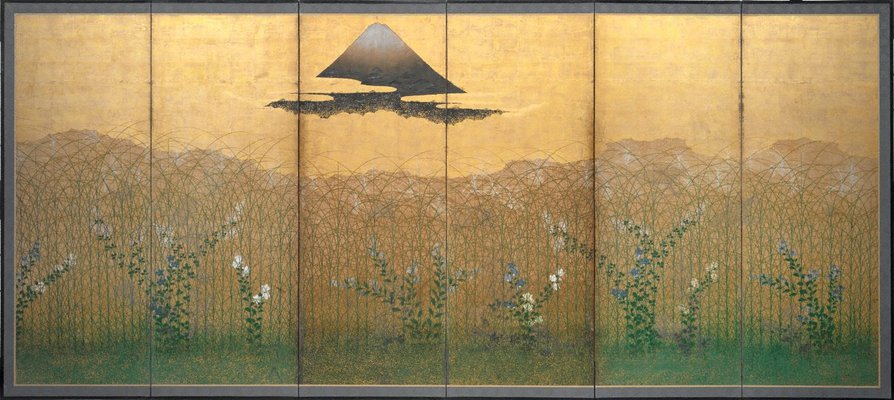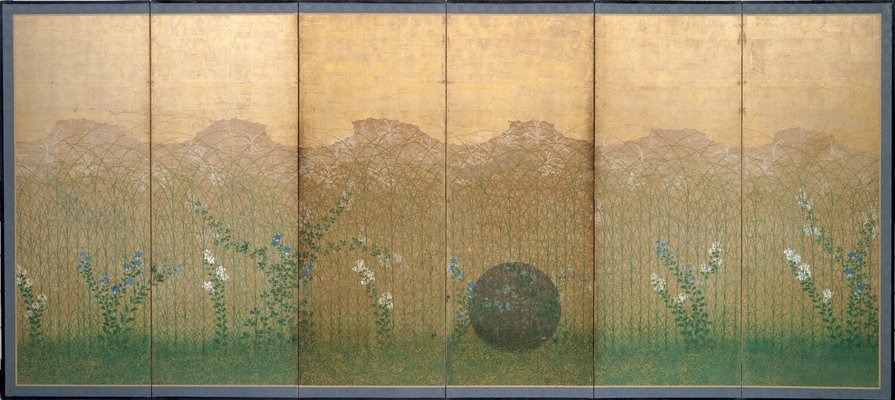

-
Details
- Alternative title
- Musashino zu byôbu
- Place where the work was made
-
Japan
- Period
- Edo (Tokugawa) period 1615 - 1868 → Japan
- Date
- late 17th century-18th century
- Media categories
- Screen , Painting
- Materials used
- pair of six-panel screens (byobu); ink, colour and gold on paper
- Dimensions
-
a - right screen - moon, 156 x 360 cm
b - left screen - mountain, 156 x 360 cm
- Signature & date
Not signed. Not dated.
- Credit
- Art Gallery of New South Wales Foundation Purchase 2000
- Location
- Not on display
- Accession number
- 143.2000.a-b
- Copyright
- Share
-
-
About
Screens depicting Musashino are one of the great classical subjects of Japanese art. In Japanese painting there is a specific category (called 'meisho-e', literally 'famous places') for the most revered places, which are usually those immortalised by famous poems and/or literary tales. Such a place is Musashino: every Japanese responds to the poetic associations of Musashino which appears in Chapter 12 of the famous Ise Monogatari (Tale of Ise), a 10th century collection of lyrical episodes. In Chapter 12, a man kidnapped a young woman and concealed her among the grass of Musashino when they were pursued by the provincial governor. As the governor was about to light the grass to flush out the lovers, the young woman wrote a poignant 'waka' (particular Japanese poetic form): 'Please do not burn the fresh grass of Musashino. Both he and I are hidden within'.
Another layer of poetic association was added with the poem by Minamoto Michikata (1189-1238):
'On the Musashi plain
There is no mountain
Behind which the moon disappears.
It rises and sinks among the grass.'It is the latter poem that inspired the typical format of Musashino screens: on the left a full autumn moon rises through autumn susuki grass, wild chrysanthemums, bush clover, pinks, and Chinese bell flowers. The right screen depicts Mt Fuji, another 'meisho-e' layered in religious (Shinto), poetic and literary allusions, above an equally lyrical depiction of autumn grasses. This screen is a visual panegyric to the beauty of Mount Fuji as seen in autumn from the vast plain of Musashi which once existed to the south-west of Tokyo.'
-
Places
Where the work was made
Japan
-
Exhibition history
Shown in 1 exhibition
Glorious, Art Gallery of New South Wales, Sydney, 27 May 2017–06 Jan 2019
-
Bibliography
Referenced in 5 publications
-
Chiba City Museum of Art (Editor), Shukufuku-sareta shiki -- Kinsei Nihon kaigano shosô, Japan, 1996, 56-57 (colour illus.). cat.no.18
-
NAKAYAMA Kiichirô and SUEYOSHI Takeshi (Editors), "Yû/ Gei" no bi: Classical Artworks of Japanese Pastime, Japan, 1997, 52-53 (colour illus.). cat.no.46
-
Jackie Menzies (Editor), The Asian Collections Art Gallery of New South Wales, 'The aesthetic of transience', Sydney, 2003, 204-205 (colour illus.). The colour illus. on page 205 is a detail of this work.
-
Ôsaka Municipal Museum of Art (Editor), Wa-no ishô: Japanese Design, Ôsaka, 1998, 104-105 (colour illus.). cat.no.136
-
Michael Wardell, Look, 'Foundation building', pg.14-17, Sydney, Sep 2004, 17.
-
